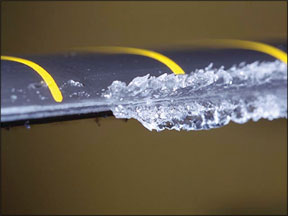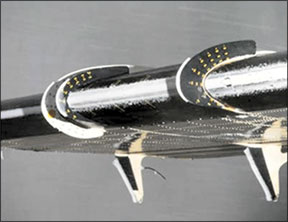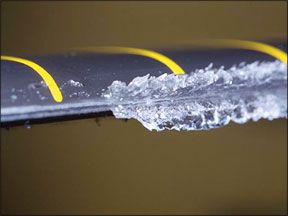Even as the wreckage of Colgan Flight 3407 cooled in a Buffalo, N.Y., neighborhood in mid-February, the debate over flying turboprops into known icing was reigniting. Whether icing was the cause isnt known, and actually isnt relevant to the fact that this accident reminded everyone in the industry of an unresolved safety question: Are turboprops equipped with pneumatic boot de-icing systems really capable of handling all the icing they might be expected to encounter? And if they arent, how can pilots be trained to safely recover an airplane thats been iced up beyond the equipments capability or, worse, survive an icing encounter in an

288
airplane with no ice protection?
Another early question arising from this tragedy involves reports of what might be considered inappropriate control inputs as the Bombardier Q400 departed controlled flight. According to the NTSB, information retrieved from the flight data recorder indicates the stall-warning stick shaker and stick pusher activated soon after landing gear deployment and wing flap extension to 15 degrees down. At that time, the aircraft then pitched up 31 degrees, far in excess of a normal maneuver in a transport-category airplane.
While its entirely possible the pitch up involved the autopilots automatic and simultaneous disengagement, its also possible the maneuver was commanded from the flight deck. Why would the crew pitch up so severely? One explanation involves the crews presumption the tail had stalled. In such an event, the appropriate response is to pitch up, not down as would be the case if the wing entered a stall.
Generally, the only way a tailplane is going to stall in normal operations is if its leading edge somehow becomes contaminated, as would be the case if ice accumulated.
Few pilots fully understand the aerodynamics of tailplane stalls, how they present and what are the appropriate recovery techniques. Thankfully, NASA has conducted in-depth research on the phenomenon. While the NTSBs investigation and industry speculation continue, this is a good time to visit the issue of icing-induced tailplane stalls, irrespective of what the final probable-cause determination may include.
Another Word On Icing
When considering a Part 25 turboprop transport operating in scheduled service, it can be difficult to think of it as susceptible to what by all accounts was run-of-the-mill icing. Like CAR 3/Part 23 personal airplanes, however, turboprops spend most of their time operating at altitudes where icing is at its most prevalent and severe.
The overarching mistake is blundering into icing in the first place. More accurately, blundering into ice and not responding to it in time to survive. Weve written on this subject often, with an emphasis on new weather products theoretically improving the odds of avoiding icing altogether. Another common mistake is not exiting the ice quickly or getting into a situation where there is no exit-no warmer air above or below, terrain restrictions or conditions just too sporting for the airplane and pilot to handle.
If youve made those mistakes and youve still survived, the end game is all tactical: how to land an airplane thats carrying a load of ice. Everyone knows-or should-that airplanes carrying significant ice are aerodynamically compromised in unpredictable ways. Moreover, the same airplane may behave differently in different icing encounters.
Some general observations: When the main wing is collecting ice, the horizontal and vertical fins also collect it. Because sharp-edged surfaces collect more efficiently, they probably will have more of it. Stall speed will increase by some unknown value and the tailplane will be more susceptible to stalling, causing momentary loss or reduction of nose-up pitch authority.
There may also be unexpected handling funnies, such as reduced roll control, buffeting and vibration from ice on various surfaces, not the least of which is the prop. Airspeed may decrease even before you notice much accretion and climb rate will be inhibited by a little or a lot. The windshield may ice over, which has turned relatively mild icing events into wrecks because the pilot loses his flare and directional cues.
The takeaway is that if your airframe is iced up enough to notice, it might not behave normally and you should respond accordingly.
Drag and AOA
The main performance killer is drag and the effect icing has on the stall angle of attack and, indirectly, stall speed. Aircraft manufacturers, NASA and the de-ice equipment purveyors have done enough research to demonstrate even relatively benign ice accretion-if there is such a concept when it comes to icing-on a wings leading can reduce the maximum coefficient of lift by as much as 30 percent, according to Dennis Newtons excellent treatise on the subject, Severe Weather Flying.
The more insidious aspect? The stall angle of attack decreases, which translates to a higher stall speed, the exact value of which depends on the wing and the amount and type of ice. Newtons research revealed a mere 1/8 inch of ice can raise stall speed from 69 knots to 80 knots, a 16-percent increase. That means the usual hack of adding 10 knots for the wife and kids wont be close to enough.
The Tailplane Problem
If understanding why a wings stall AoA decreases with ice accretion is easy to grasp, wrapping your head around what the tailplane is doing isnt. It has its own AoA considerations and recovering from a tailplane stall is the polar opposite of a main-wing stall, even though the two may present themselves similarly.
The Buffalo crash brought tailplane stalls to the fore again for good reason: At least two turboprop airliners have crashed as a result of suspected tailstalls, and there have been other incidents in which ice on the tailplane played a role. The sidebar on page 9 explains why turboprops may be uniquely at risk for tail stalls, if not tailplane icing.
Youll recall from your private pilot written that in most airplanes, the wings center

288
of lift is aft of the center gravity. This results in a nose-down moment that the tailplane counteracts by exerting downward lift around the pivot of the CG. But like the main wing, the horizontal stab has an AoA limitation and it will stall if its exceeded. In normal flight, thats just about impossible to do. But flight with ice on the airframe is anything but normal.
Ice acts like a stall fence, causing the air that would otherwise smoothly pass over the leading edge to detach and disrupt lift-a stall. And just as with the main wing, the rearward flowing air can reattach aft of the initial turbulent area. If the tailplane AoA is high enough, the flow can reattach beyond the elevator hinge line, causing noticeable buffeting through the elevator, light to negative nosedown pitch forces and heavy-almost irresistible-nose-up pitch force.
The diagrams on the opposite page attempt to explain whats going on by depicting flow, separation, resulting downforce and representative angle of attack for clean (top) and ice-contaminated tailplane airfoils (remainder).
Flaps Are Bad
Extending flaps may aggravate the tailplane stall problem. Flap deployment produces downwash that can change local airflow enough to radically increase the tailplane AoA, resulting in an immediate tailplane stall. Further, in level flight, the main wing has a slightly positive AoA, the tailplane a slight negative AoA. In many airplanes, flaps tend to lower the main wing AoA which raises the tail slightly, increasing the tailplane AoA closer to the stall value.
Also, when flaps are extended, the main-wing center of lift moves further aft, increasing the nose-down moment and requiring the tail to provide more downforce. The more downforce required, the greater the negative AoA is on the tailplane. Another aggravator of tailplane stalling is power, or excess power. This increases flow over the wing and tailplane, intensifying the stall condition and decreasing the amount of downward lift available to counter the nosedown pitch moment.
If this sounds confusing, the recovery procedure for a tailplane stall is even more so. Rather than lower the pitch and add power, as in a wing stall, you do the opposite: elevator back and reduce power, or certainly not increase it. This has the effect of raising the nose and reducing the tailplane AoA, unstalling it.
Identifying It
The trickier part is discerning a tailplane stall from a wing stall. A tailplane stall should present with buffeting or forward-tending lightness in the elevator, but not buffeting in the airframe itself. It may be accompanied by incipient or strong nose-down moment.
By contrast, a wing stall may present with buffeting in the airframe or ailerons, but also nose-down moment if the stall develops. If you think making the fine point distinction between the two in the heat of battle is difficult, youre right.
Surviving It
With these basics in mind, lets assume you exited the icing, but not before you picked up a significant load. Whats the best way to handle the approach and landing? First, if possible, pick an airport where you can land visually. Nothing complicates this process more than trying to do it entirely on the gauges. However, if an ILS is available and its practical to fly it, doing so will give you good vertical guidance, especially if the windshield is opaque from ice. Dont couple the approach; hand-fly it so youll have a better feel for control pressures.
On the approach, remain as high as you can for as long as you can, without requiring a hair-on-fire dive for the runway. Plan on an approach speed higher than normal with reduced or no flaps. How much higher the speed should be is another unknown. Dennis Newton recommends 20 percent while others recommend between 10 and 20 knots.
If the runway is long, wouldnt more speed be better? No. Higher speed will aggravate the tailplane stall risk because the main wing will be at a lower angle of attack and the tailplane at a higher angle. Theres a balance between the two speeds and youll have to fish for it. The argument for and against flaps cuts both ways. Adding some flaps will lower the stall speed. Approaching with no flaps will require a higher speed because youre adding some gouge value to the clean stall speed-call it 15 knots.
Also, remember you have to land out of the approach. If you cross the threshold at a blazing 140 knots and the runway is 3500 feet long, you could run out of runway and ideas all at once. That argues for picking the longest runway you can find and an approach speed thats sensibly above the clean stall speed, but not too much above it. Of course, since you picked up ice, its probably winter, which means that the runway could be wet or ice covered, adding yet another complication to an already tense exercise.
In its extensive research project on tail stall issues in 1998, NASA recommended that if flaps are used, they should be deployed at an altitude permitting recovery from any induced tailplane stall. Make any configuration changes-power, flaps, trim, landing gear-gingerly and one at a time. Be spring-loaded to undo any configuration change that causes controllability issues.
With an unknown stall speed, the best plan is to set up a long straight-in approach at a stable speed. Avoid circling, even if it means landing with a slight tailwind, runway length permitting.
Minimize the flare. Fly the airplane on and slow it in ground effect. Our review of icing accidents indicate a substantial number of airplanes survive the icing encounter only to stall short of the runway or right over it because the pilot tried to fly some semblance of a normal approach and landing. This is common for twins, which may have the power to drag a bunch of ice to the runway, only to lose lift and mush in when the power is reduced in a normal flare.
Summarizing
Our point is to improve pilot awareness of the potential tailplane stall. Since sorting out a wing stall from a tail stall and recovering properly might very well be beyond the ability of many pilots in the time available, its far preferable better to avoid the tailplane stall in the first place. This means-number one-avoiding an icing situation. If youre past that point, respond to the situation by flying at a prudent speed, make minimal configuration changes and deploy little or no flaps.
If theres any good news about any of this, its that the accident record suggests that if you emerge from the icing conditions able to hold altitude, the chance of a safe outcome on a runway is reasonably good. But if you let icing progress to the point tailplane aerodynamics are affected, your options are sharply limited.




